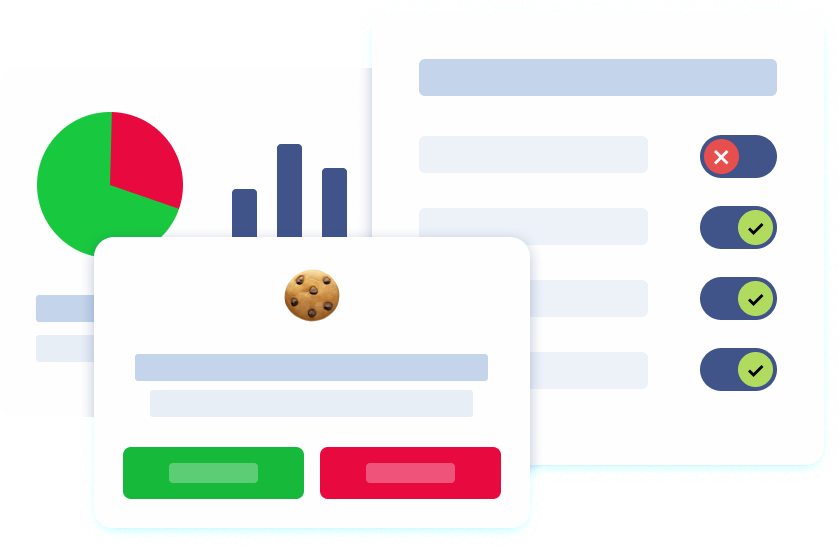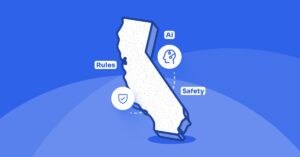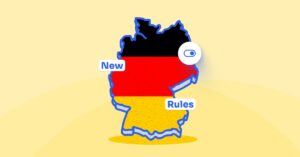Introduction
When running an online business, website owners must comply with data protection laws that regulate how personal data is collected, stored, and used. Two of the most important legal documents are the privacy policy and the cookie policy. While many website visitors assume they serve the same purpose, in reality, they address different aspects of data protection and user privacy.
Both privacy and cookie policies inform users about how websites collect data, but each policy focuses on different aspects of data collection.
A privacy policy explains how a website handles users’ personal data, such as contact details, payment information, and location data. It also describes data practices, including how long data is stored (data retention periods), who the data controller is, and whether there is any data sharing with third parties.
In contrast, a cookie policy focuses on cookie usage and similar tracking technologies like web beacons and analytics cookies. It informs users about how these tools track user behavior, the categories of cookies used (session cookies, third-party cookies, non-essential cookies), and how users can disable cookies or manage them via a cookie banner or consent management platform.
Both are essential components of legal compliance under the General Data Protection Regulation (GDPR) and other data privacy laws, ensuring that website users receive detailed information about data collection, data processing, and data protection measures.
Understanding Policies
A privacy policy is a broad legal document that describes how an organization manages data subjects’ personal information collected when users interact with a site. It must cover:
- What types of data are collected (e.g., email addresses, payment details, long personal data, or location data)
- The purposes of data usage (e.g., account creation, payments, or customer support)
- The legal basis for data processing (such as explicit consent, contract necessity, or legitimate interest)
- How data protection measures safeguard users’ personal data, and explain how the organization protects personal data
- The rights of data subjects, including data portability, the right to withdraw consent, and the right to erasure
Meanwhile, a cookie policy is narrower in scope but equally vital. It provides a detailed explanation of cookie data practices, including:
- Types of cookies used (essential cookies, non-essential cookies, analytics cookies)
- The role of third-party cookies in advertising and marketing
- Options for cookie management, including how users can disable cookies on their devices
- How cookies and other tracking technologies monitor user behavior
Together, privacy and cookie policies give website visitors transparency and user control, strengthening trust and helping businesses avoid regulatory issues.
Legal Requirements
Under the General Data Protection Regulation (GDPR) and related data privacy laws, businesses must publish both a privacy notice and a cookie policy. These must be easily accessible, often linked in the website footer, and displayed through a customizable cookie banner.
Key legal obligations include:
- Informing users about the personal information collected and its intended use
- Obtaining user consent for non-essential cookies and similar technologies before activation
- Managing and documenting cookie consents to comply with regulations like GDPR and CCPA
- Explaining how long data will be retained (data retention periods)
- Offering clear instructions for withdrawing consent and managing cookie preferences
Failure to comply can result in fines, legal action, and reputational damage. For instance, GDPR penalties can amount to as much as 20 million euros or 4% of the global annual turnover, whichever is greater.
Legal compliance is not optional—it is the foundation of responsible data management and data protection for any online business.
Critical Differences
When comparing cookie policy vs privacy policy, the critical differences are in their scope and purpose:
- Privacy Policy: A broad overview of all data handling practices, covering personal data, data retention, data sharing, and data protection measures.
- Cookie Policy: A focused document explaining cookie usage, cookie consent, and the functioning of similar tracking technologies.
Many organizations choose to keep the cookie policy as a separate document from the privacy policy for legal and practical reasons, ensuring compliance and clarity for users.
While both protect user privacy and users’ personal data, the privacy policy deals with all aspects of data processing, while the cookie policy zooms in on cookies and similar technologies.
Both policies are essential components for building trust with website users, demonstrating transparency, and showing that website owners respect user preferences and user rights.
Data Protection Measures
Strong data protection measures are vital to ensure that the data collected remains safe from unauthorized access or misuse. Both privacy and cookie policies should explain the security measures in place, such as:
- Encryption of payment information and contact details
- Secure data transfer protocols (HTTPS, SSL/TLS)
- Access control policies limiting who can handle users’ personal data
- Auditing and monitoring of data practices
Additionally, website owners must outline how they protect against unauthorized data sharing, breaches, or misuse of cookie data.
By documenting these safeguards in both policies, businesses not only ensure legal compliance but also build long-term trust with website users who value data privacy and user control.

Data Retention and Privacy
Data retention is another critical factor. The GDPR requires that personal data not be kept longer than necessary for the purpose for which it was collected.
A privacy policy should clearly state:
- How long data is stored (e.g., account data retained while the account is active)
- Conditions for deleting or anonymizing personal data after it is no longer needed
- Policies regarding data retention periods for payment details, contact details, or location data
The cookie policy must also explain the lifespan of cookies, distinguishing between session cookies (that expire when the user closes the browser) and persistent cookies (that remain on the user’s device for set periods).
Clear policies on data retention show a commitment to data privacy, legal compliance, and respect for user rights.
Cookie Banner and Policies
A cookie banner is the most visible tool for obtaining user consent regarding cookie usage. It serves as the entry point for cookie management and ensures compliance with legal requirements.
Best practices for a cookie banner include:
- Displaying a customizable cookie banner immediately when a visitor lands on the site
- Offering clear options to accept, reject, or customize user preferences
- Providing links to the cookie policy and privacy policy for detailed information
- Making it easy for users to later withdraw consent or adjust cookie data settings
A well-designed cookie banner demonstrates transparency and respect for user control, while also ensuring compliance with data protection laws.
The Importance of Transparency
Transparency is at the heart of modern data protection laws, including the General Data Protection Regulation (GDPR). For website owners, this means more than just legal compliance—it’s about building trust and empowering users to make informed choices about their personal data.
A transparent approach requires website owners to clearly inform users about their data collection practices, including the use of cookies and similar tracking technologies such as web beacons. This involves providing detailed information on what data is collected, how it is used, and the legal basis for data processing. By explaining the types of cookies used, their purposes, and how users can manage or disable cookies, website owners help users understand and control their data usage.
Transparency also extends to how data protection measures are implemented, how long data is retained, and what rights data subjects have regarding their personal data. Clearly outlining these details in privacy and cookie policies ensures users know how their information is handled and protected.
Obtaining explicit user consent is another essential component of transparency. Tools like a consent management platform and a customizable cookie banner allow users to set their preferences, accept or reject non-essential cookies, and withdraw consent at any time. This level of user control not only meets legal requirements but also demonstrates a genuine commitment to data privacy.
Importantly, transparency is not a one-time effort. Data collection practices, cookie usage, and legal requirements evolve, so website owners must regularly review and update their policies to reflect current data management standards. Keeping users informed about any changes further strengthens trust and supports ongoing compliance.
By prioritizing transparency, website owners can protect users’ personal data, respect their rights, and foster a positive relationship with their audience. This approach not only helps meet the demands of data protection laws but also enhances the reputation and success of any online business in today’s privacy-conscious digital landscape.

Conclusion
So, are cookie policies and privacy policies the same thing? The short answer is no—they are separate documents that serve distinct but complementary purposes.
- The privacy policy provides a broad overview of data practices, including how personal data is collected, processed, stored, and shared.
- The cookie policy focuses specifically on cookies and similar technologies, offering a detailed explanation of how they track user behavior and how website visitors can manage them.
Both policies are essential components of legal compliance for any online business, ensuring transparency, accountability, and respect for user privacy. By providing both documents in an easily accessible manner and ensuring they contain detailed information, website owners not only meet legal obligations but also foster trust with their audience.
For businesses aiming to stay compliant with the General Data Protection Regulation and other data privacy laws, understanding the key differences between these two policies is critical. By implementing strong data protection measures, responsible data retention practices, and effective cookie consent tools like a cookie banner, companies can ensure they protect personal data while empowering users with real control over their digital experience.



